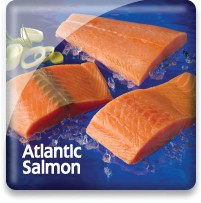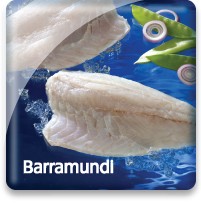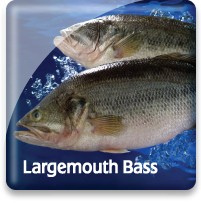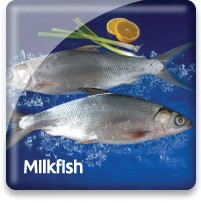
Barramundi

Market Name: Eating QualitiesRaw, the flesh color ranges pearl to pink; and cooked the meat is white and possesses a sweet, delicate flavor. The meat from wild-caught Barramundi is similar, but has a bigger flake and more robust flavor.
Barramundi is an Australian Aboriginal word meaning “large-scaled river fish.”
In their natural habitat, barramundi can grow quite large, up to 130 pounds.
|
Description & CharacteristicsBarramundi is a very large fish that lives in freshwater and goes to sea to spawn. Commercially available specimens usually range from 3 to 30 pounds. Efforts to increase the resource through aquaculture and stocking are intensifying. The white meat has a sweet, buttery taste and succulent, delicate texture. Barramundi is comparable to wild Sea Bass but moister and more delicate. The white flesh has fairly high oil content, cooking up white with good-sized flake. In the wild, barramundi or Lates calcarifer, is a very large fish that lives in freshwater but goes to sea in order to spawn. This diadromous species can be found in the waters of subtropical and tropical Australia where it is a prized sport fish, and Southeast Asia. Commercially available from 3 to 30 pounds, barramundi grow for several years in the rivers before returning to the estuaries to spawn. Mature fish are also found in coastal waters. Most barramundi begin life as males, and change to females later in life; somewhere between six and eight years old. Consequently, the largest specimens are generally females. The wild fishery accounts for roughly 60 percent of production, but aquaculture efforts are intensifying and growing substantially each year. The capture fishery is dominated by Indonesia, but both Australia and Malaysia contribute to the world supply. Barramundi are hardy and fast-growing, which makes them suitable for aquaculture. Farmed barramundi can grow to market size of 1.5 to 2 pounds in less than a year. The leading aquaculture producers are Taiwan, Malaysia and Thailand. World production of barramundi is now roughly 168,000 metric tons a year, growing both in terms of wild catch and aquaculture production. Global aquaculture has grown from 21,000 MT in 2000 to 66,000 MT in 2010; an astounding 214 percent. The emergence of successful aquaculture has led to expansion in the lucrative North American and European markets. Chefs and restaurateurs are attracted to the white meat that offers excellent quality and possesses a sweet, delicate flavor. The meat from wild-caught barramundi is similar, but has a bigger flake and more robust flavor. The few bones in the fish are large and easy to remove. Barramundi has a high enough oil content to keep the flesh moist while cooking, lending itself to a myriad of preparations. Many times the fish is prepared pan seared with the edible skin left to crisp-up nicely.
Barramundi is typically available as fresh whole, H&G and fillet; and frozen in fillet form.
Other Resources |
Handling Instructions for Barramundi
Barramundi fillets should be stored at or below 0°F (-18°C) and then thawed properly when ready to cook. Frozen shelf life is 18 months. Links to proper seafood handling instructions: NOAA - Fish Watch: Handling Seafood and A Consumer Guide to Safe Seafood Handling.
Thawing Barramundi
Thawing is accomplished by placing the product in a sealed plastic container or bag and placing in the refrigerator (33 to 39°F) for 12-24 hours. This is our recommended thawing method for fillets. Fillets that are not consumed promptly after thawing need to be refrigerated between 33 and 39°F and totally consumed in 2-3 days.
Important Instructions for Barramundi
Consuming the fillets immediately after proper thawing yields the best quality.
The Federal Food, Drug and Cosmetic Act now requires that all foods that are not raw agricultural commodities and that contain a major food allergen be labeled to clearly identify the name of the food source form which the allergen is derived. (21 CFR U.S.C. 343(w)(1)). The act defines eight foods, and any ingredients derived from these foods as major food allergens: Fish, Crustacean Shellfish, Milk, Eggs, Tree Nuts, Peanuts, Wheat & Soybeans. The name of the food source that must be listed on the label for fish or crustacean shellfish must be the specific type of fish or crustacean shellfish. The market names of species of fish and crustacean shellfish should be used to identify the food source of these two major food allergens. If you intend to re-pack these seafood products, be sure the allergen is declared in either one of two ways:
1) Within the list of ingredients
or
2) In a separate “Contains” statement immediately after or adjacent to the list of ingredients.
Consult the Fish and Fishery Products Hazards and Controls Guidance, Fourth Edition, Chapter 19 for more detailed information on the labeling of food allergens.
Cooking Tips
Barramundi fillets can be prepared using a wide variety of cooking techniques. Links to cooking tips and recipes.
Taiwan
The island of Tawian, shaped like a tobacco leaf, nation, is located off the coast of China where it is officially part of the Republic of China. Some 23 million people live in an area that is just 245 miles long and 89.5 miles wide, making Taiwan the second-most densely populated country in the world.
While it offers few opportunities for recreational fishing, Taiwan’s commercial fishing industry is well-established, with a fleet of vessels that fish around the world for tuna, sharks, herring, reef fish, horse mackerel, sardines, squid and octopus. Aquaculture is also an important new industry in Tawian, with freshwater farms growing shrimp farms, and tilapia, and marine farms growing shellfish such as clams and oysters.
Vietnam
With a coastline of 2,140 miles, as well as numerous rivers and lakes, Vietnam has had a long tradition of fishing and a culinary tradition that includes finfish, shellfish, and molluscan shellfish.
Bordering China in the far North, and Laos and Cambodia in the middle and Southern regions, the country—known officially as the Socialist Republic of Vietnam—is divided into 58 provinces, and includes several major sea ports.
With seafood production surpassing USD $6 billion in 2012, seafood—both cultured and wild—represents an important export for this developing country.
Major seafood exports from Vietnam include cultured and wild shrimp: Black Tiger prawns and Penaeus vannamei are grown in Southeast Vietnam, and small white and pink shrimp are still commercially caught in the South China Sea off the southern coast.
In addition, Vietnam is becoming known for its high-tech seafood processing industry, adding value to commercially harvested and farmed fish and seafood.
Species that are commercially caught include Grouper, Red Snapper, Red Mullet, Tuna, Swordfish, and Barramundi—which are the major species that are exported to Australia, the United States, and the EU. Vietnam is also a major producer of farmed Tilapia, and two species of Pangisius (boucourti and hypothalamus). Squid and octopus, as well as various species of lobster and crab and molluscan shellfish are also major export products as well as products consumed in-country.
| . |
Go Blue! Seafood Sustainability Spectrum
*Click here for an explanation of our Sustainability Spectrum Sustainability AssessmentBarramundi are native to the Indo-Pacific region where they can be found in both freshwater, brackish water, and saltwater environments. Sea Port sources their farmed Barramundi from Vietnam, China, and Taiwan.
Barramundi are a good species for farming because they are very tolerant of many production challenges, such as temperature changes and crowding. Sea Port sources from farms that produce from primarily earthen ponds. These ponds make is easier for farmers to monitor and reduce pollution discharges, escapees, diseases, and feed inputs when compared to farmers using open pen/cage production methods in lakes or marine habitats. 
Environmental Impact: ModerateBecause Barramundi require a lot of protein in their diet, they have historically been fed pellets that contain wild fish as an ingredient. However, advances in feed formulations that substitute various grain meals and animal byproducts for fishmeal have greatly reduced the amount of marine feed inputs to around 10-15%. Barramundi farming shares the same universal environmental risks associated with most finfish pond/pen/cage aquaculture in terms of trying to minimize diseases and its spread, chemical/antibiotic use, pollution, escapees, and disruption to local fauna, flora, and to the hydrology of the local habitats in which production is occurring.
Sustainability Improvements NeededBest aquaculture practices are advancing rapidly for finfish aquaculture around the world and Barramundi farming is participating in these advancements in the Indo-Pacific countries of China, Vietnam, and Taiwan. Advancements in feed formulations will help to further improve the environmental sustainability of Barramundi farming.
Actions that Sea Port is UndertakingSea Port is promoting the occasional consumption of farmed Barramundi based on our belief that a wide variety of farmed seafood holds the best promise to relieve pressure on our wild fisheries while increasing the availability of high quality and healthy seafood. Barramundi certainly adds to this variety and we foresee progress in the development of new feed formulas to further reduce the content of marine resources. We created the sustainability assessments for each of our seafood items in order to reveal the existing and potential environmental impacts and risks that are associated with producing them for human consumption. This allowed us to establish the starting position for each of our seafood items along our progressive Go Blue! Seafood Sustainability Spectrum®. These assessments are only a single snapshot in time and because of this, we will continue to assess and update the critical sustainability needs associated with our supply sources and issue updates to the Go Blue! Seafood Sustainability Spectrum® as needed. There is a growing global awareness for the need to assure the sustainability of farmed and wild caught seafood and because of this; all around the world positive changes are rapidly occurring at all levels of the seafood supply chain. We will continue to spread this growing awareness and work with our many industry partners to improve the sustainability of all seafood, which we believe is the ideal protein of choice to feed an ever growing world population. Our Go Blue! Seafood Sustainability Spectrum® serves as our compass and yardstick as we strive to move all our products forward to becoming more sustainable. Please join us in this committed quest and Catch Our Wave® to sustainability by choosing a diverse variety of responsibly produced seafood as part of your diet.
|














